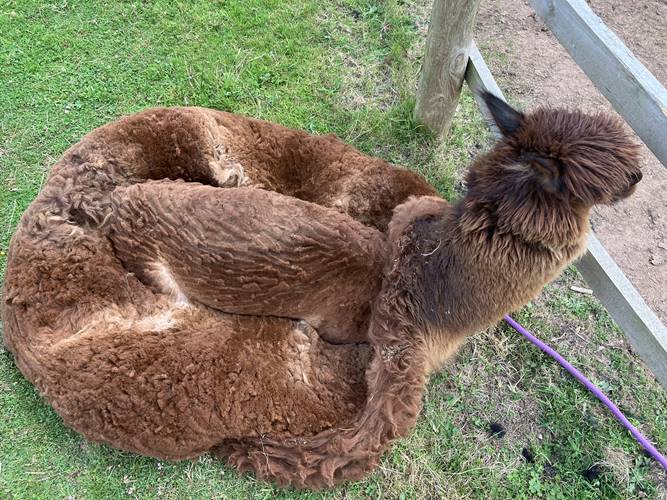A little bit about alpaca fleeces
The rainy, temperate climate of England or even Scotland hardly offers a suitable habitat for alpacas. They originate from Peru, more precisely the Andes known for their dry, extremely cold and unforgiving climate. Alpacas along with other members of the camelid family, llamas, vicunas and guanacos, are built to sustain such harsh living conditions. They are very compact and hardy animals gifted with a thick and dense coat that not only keeps them dry but insulates them from the intensely freezing cold of the winter months. Their fibre has been praised for its softness and fineness and for being hypoallergenic as it is lanolin free..
The quality of an alpaca fleece is measured in micron and how much crimp it holds. The smallest the micron, the softer the resulting yarn will be and the least amount of itchiness it will cause when wearing the knitted garment. Only a small part of the animal fleece is used for spinning purposes, Called the blanket, it is harvested once a year from the back and sides of the animal as shown on the picture of Topaz below. The rest of the fleece, comprising the neck, underbelly and legs may be used for carpet making, stuffing or insulation or just be discarded.
One of the parameters of breerding alpacas is to follow a genetic line of animals who will grow hair of the finest quality. Not all animals are born with such specifics and their fleece may not necessarily meet the criteria required by the spinning industry.
It takes hundreds of animals to make a profitable business out of alpaca fleeces. Processing the fleeces is a costly process as they need to go through various and time consuming stages before even being ready to be spun into yarn. This only becomre worthwhile with a large herd of animals. Most small holders discard the fleeces as there is little or no money to be made from them.

My very own alpaca experience
My herd is tiny and counts only 5 animals who live in a closely tight knit.
As i have invested myself deeply in the care of my animals, i decided to fulfill my experience of alpaca keeping to its final stage: Have their fleeces processed and spun into yarn.
i have kept their fleeces (only the back or blanket) for 2 to 3 years until i collected enough of each color to make it worthwhile, hoping to al least recover my cost.
Shearing my animals has always been an immense pleasure, the touch of their hair as i am shearing is truly a sensual experience, the moment of trust i spend with them as they let me run the shears through their coat has been inspirational and the resulting yarn spun into a neatly presented soft and smooth ball has been incredibly rewarding. Alpaca yarn is such a noble, luscious and luxurious gift.
The colours are the natural colour of the animals and the yarn you will receive comes from the very animal pictured on the product page. 100% traceable right down to the very animal!
Quality
The batches we currently have for the black, brown and dark beige yarns were made from fleeces when the animals were 2, 3 and 4 years old.
The off-white yarn comes from Willow who is older and therefore does not have a fleece as soft as a younger animal.
Nevertheless, it is still alpaca yarn and softer than sheep.
What to Knit or Crochet
Alpaca yarn doesn't have the spring quality of sheep wool. So large pieces tend to stretch and fall out of shape.
It is best suited to knit or crochet small pieces, such as hats, gloves and scarves.
Caring for the animal whilst shearing
With their long and unusual neck, alpacas may look a little exotic and amusing to us. They have a luscious, smooth coat that make them look like Teddy bears and it is hard to resist the urge to touch, pet and cuddle. This doesn't happen often as these animals do make it truly hard work for us to look after them. Although there is nomore alpacas in the wild and they have lived as domesticated animals for a very long time, they have retained a strong wild instinct and do not give their trust with ease. An enormous amount of time and bagfuls of patience are the pre-requisits before contemplating the idea of keeping alpacas. Their first reaction is very much rooted in a fear and flight mode which makes every little bit of care they need to receive feels like an expedition. Shearing is no exception and is possibly the worst for the animal. They really do not help themselves. Videos on shearing alpacas can easily be found on youtube. It is a process that i used in my early days as an alpaca keeper as i didn't know any better. I have always profoundly dislliked it and have done my best to get my animals to get used to my touch. I have succeeded mostly and my youtube channel shows how much i have achieved. I shear my animals myself with hand shears except for the boy Milou. I have so far got to admit complete failure on the shearing front.
Please check out the video below
https://www.youtube.com/watch?v=66jrJPC1lv0
Thank you for supporting us!